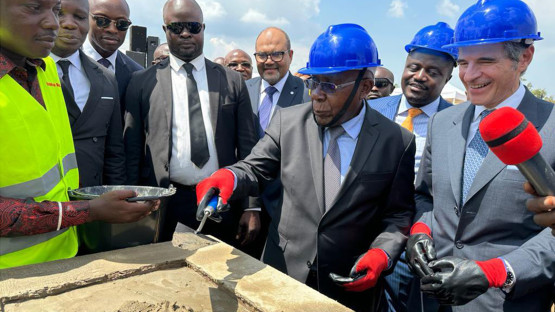The IAEA Director General Rafael Mariano Grossi met President Félix Antoine Tshisekedi Tshilombo of the Democratic Republic of the Congo on Thursday, after attending a ceremony to lay a foundation stone of the country’s first public radiotherapy centre. The country was one of the first to work with the IAEA under its flagship cancer care initiative, Rays of Hope: Cancer Care for All, which aims to widen access to life-saving radiotherapy by supporting the establishment and expansion of global radiotherapy services in many countries around the world.
IAEA Director General and President of the Democratic Republic of the Congo Celebrate Cancer Care Milestone
The foundation stone of the Democratic Republic of the Congo’s first public radiotherapy centre was laid at a ceremony attended by the IAEA Director General Rafael Mariano Grossi, Minister of Scientific Research Gilbert Kabanda Kurhenga and the Minister of Higher and University Education Muhindo Nzangi Butondo. (Photo: IAEA)
Today in DRC, we laid the first brick of the country’s first radiotherapy centre—a big step for cancer care W/ @IAEAorg #RaysOfHope.
— Rafael Mariano Grossi (@rafaelmgrossi) November 16, 2023
Aujourd’hui en RDC, première pierre posée pour le premier centre de radiothérapie du pays—un grand pas pour les soins contre le cancer avec AIEA. pic.twitter.com/5JPhW5b4Nh
Mr Grossi said: “Cancer claims too many lives, but we're changing this — one radiotherapy centre at a time. At the heart of IAEA's mission is supporting nations to bolster their cancer care capabilities. And we're actively making this happen.”
The Democratic Republic of the Congo faces a significant cancer burden, and like many low-income countries, does not have enough access to radiotherapy or medical imaging. Prior to the Rays of Hope initiative, only one private radiotherapy facility served a country of approximately 90 million people, according to an IAEA imPACT review, carried out in 2022. Most diagnostic and treatment services were only available in private facilities in Kinshasa, creating considerable disparity in access to diagnostic services across the country.
Rays of Hope
Since the Rays of Hope initiative began on World Cancer Day in 2022, the ‘first wave’ countries of Benin, Chad, Democratic Republic of the Congo, Kenya, Malawi, Niger, and Senegal have received a range of key radiotherapy and medical imaging machines – as well as training for the medical professionals needed to operate the equipment and provide safe and timely diagnostic and treatment services. The IAEA has six decades of experience in helping countries fight cancer, including in cooperation with the World Health Organization (WHO). The assistance provided by the IAEA has enabled many countries to establish and/or strengthen safe, secure and effective radiation medicine (radiotherapy, radiology and nuclear medicine) capabilities.
While in high-income countries nearly all patients have access to radiotherapy, in middle-income countries fewer than 60 percent do. In low-income countries, the figure drops to just only one in ten people with access to this life-saving treatment.
Integrated cancer care can help to prevent one third of all cancers, including some of the most common forms such as cervical, breast, head and neck, and colorectal cancers. Investments in diagnosis and treatment can enable diseases to be detected early and treated appropriately. The most prominent types of cancer in the Democratic Republic of the Congo are prostate cancer in men with around 7471 new cases annually, and cervical cancer in women with around 7772 new cases per year, according to the online cancer statistics database GLOBOCAN.
The new Centre of Multidisciplinary Diagnostic and Radiotherapy will be hosted by the University of Kinshasa. The University of Kinshasa also includes the Regional Center for Nuclear Studies and houses Africa’s first research reactor, TRICO I, now in permanent shutdown, as well as its TRICO-II research reactor.
Research reactors are powerful tools, providing life-saving medical radioisotopes for cancer care, and enabling scientific research in agriculture and industry. The Trico II reactor has been in extended shutdown since 2004, but there are plans to bring it back into service, following a series of IAEA missions aimed at enhancing nuclear safety and security at the reactor as well as putting into place ageing management plans. Mr Grossi re-affirmed the IAEA’s support to bring Trico II back into service while speaking to President Tshilombo during his visit.
Visited TRICO-II at @Unikinrdc, the site where Africa’s civil nuclear journey began.@IAEAorg will help the #DRC revive this knowledge hub. We're working on its refurbishment, prioritizing safety & security, to advance nuclear science & tech for development. pic.twitter.com/tUXbLSMxO7
— Rafael Mariano Grossi (@rafaelmgrossi) November 16, 2023
The TRICO II research reactor may also play a role in the IAEA and the UN Food and Agriculture Organization’s most recent initiative, Atoms4Food, which aims to use nuclear science to create greater food security in countries such as the Democratic Republic of the Congo. Tools provided by nuclear science can help farmers to use their scarce water resources more effectively and scientists to create to create more climate-resistant and nutritious crops. They can also help scientists more accurately measure malnutrition.
Mr Grossi said: “Nuclear science holds great potential for the Democratic Republic of Congo’s progress. The IAEA stands ready to support, especially with Atoms4Food, in tackling food insecurity and boosting agricultural productivity, contributing to the nation’s sustainable development.”
The world is in the midst of a global food crisis and the number of people experiencing high levels of food insecurity has doubled since 2020. Without action, millions more will experience hunger, as increasing climate extremes cause crops to fail, while the world’s increasing population causes a rise in global food demand.





